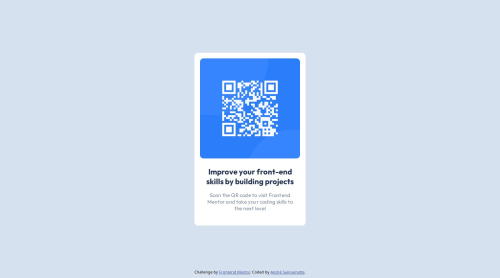QR code card component with flex-box

Solution retrospective
Using flex-box to test delivery of this first challenge. For the next challenges I hope to use some CSS preprocessor and apply some development patterns to organize the classes
What challenges did you encounter, and how did you overcome them?The biggest challenge now is to make up for lost time without practicing front-end development, I spent 4 years developing only in node, now I'm focusing back on full-stack web development to start new challenges as an entrepreneur
What specific areas of your project would you like help with?I would like tips on patterns and tools that I can study to improve front development, with more speed and if there are other development approaches such as using react or another framework to deliver the challenges
Please log in to post a comment
Log in with GitHubCommunity feedback
- P@john-mirage
Hello, nice work
Here some ways you can improve your project
- Use semantic HTML like <main> <header> <footer> etc... tags to surround your content so people with screen reader know where they are on the page.
- Use a <h1> tag for the main title of your content, it is important for people using screen readers, they cannot know that this is a title unless you use a heading tag. It also help with SEO.
- Before starting a project you can use a css reset file to have some rules to help you writting css.
- You should add a link on the image so users who don't want to scan the qr code can visit the website anyway.
- You used a fixed width on the card, you should use a relative width like 100% and use a max-width of 320px so the card will stay the same but shrink if the device viewport is less than 320px of width.
- Prefer using REM instead of PX for the sizes.
- You used a height of 100vh for the container, you should use a min-height instead so the viewport can go further than 100vh if the screen height is less than your card height.
Marked as helpful
Join our Discord community
Join thousands of Frontend Mentor community members taking the challenges, sharing resources, helping each other, and chatting about all things front-end!
Join our Discord